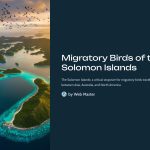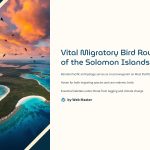 Nestled in the Pacific Ocean, the Solomon Islands play a critical role in the flyways of countless migratory bird species, acting as stopover points or seasonal homes. Recent ornithological studies have emphasized how climate change, rising sea levels, and habitat destruction are altering traditional migration routes. Birds like the Pacific Golden Plover, Bar-tailed Godwit, and several species of terns rely heavily on the Solomon Islands during their epic transoceanic journeys between Asia, Australia, and North America. These patterns are not just vital for avian life but also serve as indicators of broader environmental health. As climate shifts increasingly disrupt bird behavior, the importance of protecting these migratory paths becomes ever more urgent. Satellite tracking and global migratory networks now highlight the Solomon Islands as a hotspot of international ecological interest.
Nestled in the Pacific Ocean, the Solomon Islands play a critical role in the flyways of countless migratory bird species, acting as stopover points or seasonal homes. Recent ornithological studies have emphasized how climate change, rising sea levels, and habitat destruction are altering traditional migration routes. Birds like the Pacific Golden Plover, Bar-tailed Godwit, and several species of terns rely heavily on the Solomon Islands during their epic transoceanic journeys between Asia, Australia, and North America. These patterns are not just vital for avian life but also serve as indicators of broader environmental health. As climate shifts increasingly disrupt bird behavior, the importance of protecting these migratory paths becomes ever more urgent. Satellite tracking and global migratory networks now highlight the Solomon Islands as a hotspot of international ecological interest.

Why the Solomon Islands Are Crucial for Migratory Birds
The Solomon Islands form part of the East Asian–Australasian Flyway, one of the most significant migratory paths in the world. These birds travel thousands of kilometers annually, crossing oceans and continents in search of breeding and feeding grounds. The islands offer vital rest and refueling stops for many species, especially shorebirds and seabirds. Unique ecosystems such as mangroves, estuaries, and coral reefs provide abundant food and safe havens from predators. Without these natural stopovers, many birds would not survive the long journey.
Conservationists have identified the region as an Important Bird and Biodiversity Area (IBA), underscoring its role in maintaining global avian populations. However, increasing human activities—like coastal development and logging—threaten these habitats. Raising awareness and implementing international cooperation are crucial for preserving this ecological corridor.

Key Migratory Species Passing Through the Solomon Islands
Several migratory species depend on the Solomon Islands, most notably:
- Pacific Golden Plover: Migrates from Alaska to spend the non-breeding season in the South Pacific.
- Bar-tailed Godwit: Famous for its non-stop flight from Alaska to New Zealand, often resting on islands like the Solomons.
- Lesser Frigatebird & Sooty Tern: Oceanic birds that nest on remote islands across the archipelago.
- Eastern Curlew: One of the largest migratory shorebirds, critically endangered and in need of conservation efforts.
These species not only showcase impressive endurance but also help maintain ecological balance by participating in seed dispersal and controlling insect populations. Preserving their routes ensures the health of ecosystems far beyond the Solomon Islands themselves.

The Impact of Climate Change on Migration Patterns
Climate change is reshaping the very paths birds have followed for centuries. Rising sea levels threaten nesting areas, especially in low-lying atolls of the Solomon Islands. Changes in ocean currents and weather patterns also affect food availability, forcing birds to alter routes or skip critical stopovers.
Data from satellite tracking shows delayed migrations, declining survival rates, and habitat abandonment. The Solomon Islands, due to their strategic location, are at the front line of these ecological shifts. Protecting these zones helps buffer some of the worst effects and provides continuity for migration patterns crucial to avian survival.
International collaborations, such as the EAAFP (East Asian–Australasian Flyway Partnership), are increasingly essential to address these transboundary issues and implement region-wide conservation strategies.

Indigenous Knowledge and Community Conservation Efforts
Local communities in the Solomon Islands have long respected and observed migratory birds, integrating them into their cultural narratives and seasonal calendars. This traditional knowledge aligns remarkably with scientific observations, offering valuable insights into changes in migratory timing, population trends, and habitat use.
Community-led conservation initiatives have proven successful in managing key bird areas. These programs combine ecological preservation with sustainable development, offering alternative livelihoods through eco-tourism and environmental education. Strengthening this grassroots involvement is key to long-term preservation.
![]()
International Protection and Migratory Bird Agreements
Multiple international treaties protect migratory birds that pass through the Solomon Islands, such as:
- Convention on Migratory Species (CMS)
- Ramsar Convention on Wetlands
- Bonn Agreement
- EAAFP MoU
These frameworks provide the legal backing for habitat protection, funding conservation projects, and promoting sustainable land use. Active participation by Pacific nations, including the Solomon Islands, has led to measurable improvements in some species’ populations. However, enforcement and consistent funding remain challenges.
Aligning local policies with these international mandates ensures long-term ecological resilience and compliance with global biodiversity targets.

The Future of Avian Migration Through the Solomon Islands
The path forward involves a multifaceted approach—enhancing research, engaging communities, strengthening legislation, and securing international funding. Technology like drone surveillance, satellite tags, and AI-powered data analysis are revolutionizing how we monitor bird movements and identify threats.
Education campaigns and partnerships between governments, NGOs, and indigenous groups are pivotal to ensure that the Solomon Islands continue to serve as a vital refuge for migratory birds. With coordinated efforts, it is possible not just to preserve but enhance the integrity of these routes.
*Capturing unauthorized images is prohibited*



